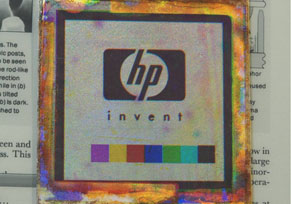A Flexible Color Display
Researchers at HP Labs are testing a flexible, full-color display that saves power by reflecting ambient light instead of using a backlight. The prototype display’s pixels are controlled by fast-switching silicon transistors printed on top of plastic. If the technology can be commercialized, the display will compete with liquid crystal screens as well as other low-power color flexible displays in the works.

“Our goal is to make a display with the color saturation of newsprint that can be manufactured for about $10 per square foot,” says Carl Taussig, director of the Information Surfaces Lab at HP’s Palo Alto, CA, research center. At this price, reflective color displays could replace paper for applications such as signs and billboards, Taussig says, although he estimates that this will take a year or two at least.
HP is collaborating with Phicot, a subsidiary of Ames, IA-based Powerfilm, which prints high-performance transistors on plastic. HP plans to target both the e-reader and tablet PC markets.
The e-reader screen market is dominated by E-Ink, a company based in Cambridge, MA, that makes black-and-white reflective displays incorporating tiny microcapsules. E-Ink’s screens have the look of paper, do not need a backlight, and do not require any power once the pixels have switched between black and white. But it is also too slow to show video and, as yet, is only available in black and white.
In contrast, Apple’s iPad uses a more conventional liquid crystal display. This means it produces vibrant color, but it is also expensive, power-hungry, and vulnerable to glare. The display is also relatively fragile because it’s built on top of glass. Many manufacturers believe there is still a market for low-power reflective displays.
Flexible display manufacturers are watching how consumers respond to the iPad. But they’re also working to develop robust reflective displays built on plastic that use less battery life without giving up the functionality of LCDs.
“Color will make all the difference,” says Nick Colaneri, director of the Flexible Display Center at Arizona State University, which partners with most of the major display manufacturers on technology development. Without color, reflective displays will be limited to niche markets, he says. Using plastic transistor arrays, which promise better durability, will also be key, he says, although major manufacturing challenges remain.
“The first company to get one of these out will have a strong position, but at the end of the day it comes down to cost,” Colaneri says. “There are several radically different approaches to manufacturing, and it’s too early to say what the costs will be.”
E-Ink is developing its own color technology, which uses side-by-side red, blue, and green filters. This means that, at any given time, each pixel might only be reflecting light from one third of its total area, which can compromise the brightness of the display.
HP hopes to deliver a brighter color reflective display technology by stacking red, green, and blue pixels in the same area. “If you want to show red, you can make the entire display red,” says Taussig.
The challenge in stacking pixels is that light is lost as it travels into and out of the stack display. “If you get loss at each layer, you get a huge overall loss, so we’re engineering the light path to prevent that,” says Taussig. HP’s best approach so far is to stack layers of red, green, and blue dye between electrically active mirrors that control whether or not light passes through each layer.
“The drawback is that it’s complicated,” says Taussig. With every layer that must be added during manufacturing, there’s more potential for errors. So the company is also developing a single-layer multicolor reflective display that uses luminescent materials to harvest light and convert it into different colors, which are then re-emitted.
A potential advantage for HP is its association with Phicot, which already makes high-performance display backplanes by printing silicon on plastic using a roll-to-roll process. “We’ve got to get the glass out of there,” Colaneri says.
Korean display company LG and Taiwanese company Prime View International are also printing silicon transistors on top of flexible materials, and both these companies have promised fully flexible displays in the coming year.
“Phicot’s approach is completely different,” says Colaneri. Instead of going through multiple rounds of etching to create a transistor array, which entails multiple opportunities for error, Phicot uses a single-step, three-dimensional lithography technique. Eliminating manufacturing steps is particularly important when working with plastic: if it bends or warps during the printing process, the layers won’t line up with one another. If HP can clear these and other manufacturing hurdles, its reflective display technology could be appearing soon on a billboard near you.
Keep Reading
Most Popular
Large language models can do jaw-dropping things. But nobody knows exactly why.
And that's a problem. Figuring it out is one of the biggest scientific puzzles of our time and a crucial step towards controlling more powerful future models.
The problem with plug-in hybrids? Their drivers.
Plug-in hybrids are often sold as a transition to EVs, but new data from Europe shows we’re still underestimating the emissions they produce.
Google DeepMind’s new generative model makes Super Mario–like games from scratch
Genie learns how to control games by watching hours and hours of video. It could help train next-gen robots too.
How scientists traced a mysterious covid case back to six toilets
When wastewater surveillance turns into a hunt for a single infected individual, the ethics get tricky.
Stay connected
Get the latest updates from
MIT Technology Review
Discover special offers, top stories, upcoming events, and more.